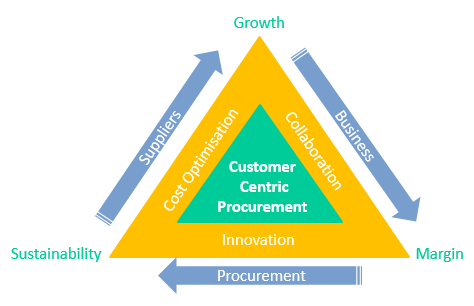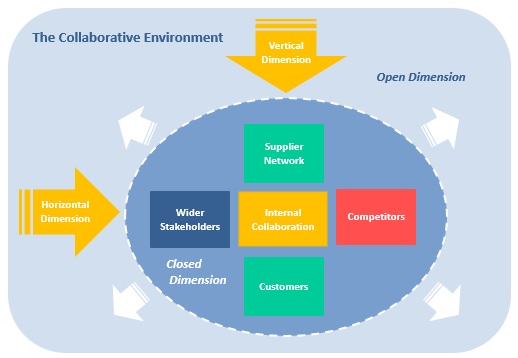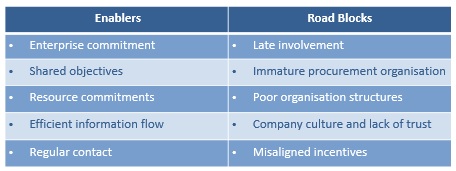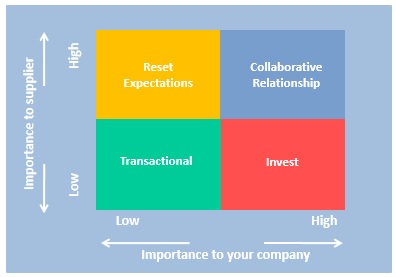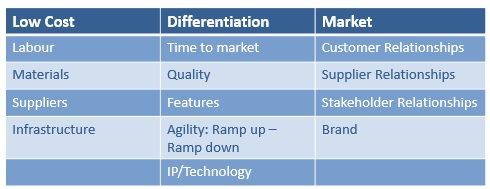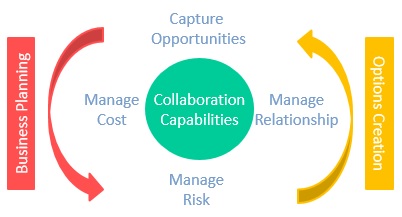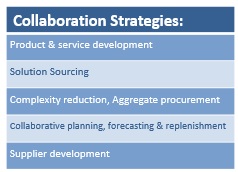Collaborations strategic value proposition can unlock the door to innovation and sustainable growth, CEO’s and CPO’s must turn the key
A guide for CEO’s, CFO’s and CPO’s on how procurement can play a lead role in partner collaboration to secure a sustainable competitive advantage
What’s in it for you?
Discover why developing a collaborative capability will support sustainable growth and higher margins, and why making Supply Management a Core Competency will provide a competitive advantage
Reading time:
15 minutes
1. The Brave CPO: Mastering Collaboration
Introduction
In today’s challenging environment, aggressive cost control sits at the top of the CEO’s and the CPO’s Agenda across all industries. But aggressive cost-cutting didn’t stop GM and Chrysler going into bankruptcy. Competitors were simply better at bringing products that customers wanted to buy to market. These competitors were better focused on the issues that deliver competitive advantage and drive growth in market share and higher margins.
‘Procurements Golden Triangle’ of cost optimisation, innovation and collaboration provides a framework for delivering competitive advantage (Fig 1) beyond cost savings.
CEO’s need a procurement function that is more value-orientated, and entrepreneurial. Arms length procurement practices will not provide the breakthrough, as GM has learned. Instead, collaborative networks with the right partners hold the key.
2. Why Collaborate
Competition and globalisation have increased the complexity of relationships significantly, and the focus is increasingly on external resources to create value. Managing collaborative relationships has become a key differentiator between leaders and laggards and the key component, the ability to collaborate can drive:
- Increased efficiency up and down the extended supply chain
- Higher levels of innovation
- Agility and faster time to market
- Optimised costs within the various members of the supply chain
- Competitive Advantage
In order to reap the rewards of collaboration, CPO’s must manage it both effectively and selectively across a wide range of internal and external stakeholders.
3. The Collaborative Environment
Purchasing Practice models the collaborative environment across two dimensions; the Open Dimension and the Closed Dimension (Fig 2).
Procurement must aim to play a key role in both dimensions. The open dimension describes the increasingly important open innovation process while the closed dimension describes collaboration along two axis; vertical and horizontal. With the right skills, procurement can be the natural partner in each dimension and across both axes. Such an approach requires a radical change in the culture and the vision of most companies in the way they manage their relationships:
- Internally
- With Customers
- With Suppliers
- With wider stakeholders
- Competitors
To succeed in the collaborative environment, CPO’s must find new, efficient ways of enabling employees, partners, suppliers and customers to collaborate, often across countries on a local, regional and global basis.
3.1 Closed Dimension
Internal Collaboration
Only by integrating and aligning with the business can procurement maximise its strategic value. CPO’s must ensure their teams are capable and ready to help shape business strategy and then to ensure full alignment of the supply management strategy to the business. They must, therefore, find new ways of integrating with their internal partners to better; work together, share knowledge to improve results, make processes more efficient and effective, and manage information.
Setting up effective governance structures is a critical task to facilitate procurement’s proactively discussing business plan inputs and contributing to the formulation of business unit strategies.
Customers
Collaborating with customers through customer centric procurement is about understanding their needs and finding better solutions to fulfill them. Collaboration with customers is the key to developing successful service solutions. In addition to facilitating solutions that meet customer need, this involvement also strengthens relationships that in turn can lead to increased loyalty and mutually benefit.
Suppliers
Collaboration with suppliers aims at improving the performance of the entire supply chain. It’s time horizon focuses longer term and for this reason it must be separated from the tactical activities of SRM. Key suppliers must be brought into the decision-making process, to capture innovation, improve processes and transparency to help resolve supply chain issues.
Wider Stakeholders
There are strong business reasons to develop long-term, collaborative relationships as part of a Corporate Social Responsibility (CSR) strategy. These relationships are founded on core corporate values and business strategy and aim to secure reputation capital, based on sound relationships with stakeholders and communities. As Apples Tim Cook recently said:
Anything can change except our values
Success results in attracting and retaining the best employees enhanced loyalty from customers, investors, and business partners and translated into improved margins and sustainable growth.
Competitors
Collaborating with your competitors is a double-edged sword. It can, however, be a smart strategy as long as both parties benefit without compromising each parties competitive position in the industry.
While procurement and supply chain collaboration between non-competing organisations such as the collaboration between PepsiCo and Anheuser-Busch for the joint buying of indirect goods and services in the US, and more recently on Super Bowl promotion are not uncommon. Collaboration between competing organisations is still rare in the procurement world.
Learning and studying your enemy can pay dividends but CPO’s will rightly ensure to protect the knowledge that is core to their competitive competencies. Procurement, Inventory Management, Transport & Logistics and Technology requirements are classic examples where collaboration could bring tremendous benefits in carefully considered circumstances.
3.2 Open Dimension
Here CPO’s must enhance their functional capability to analyse external markets beyond that which most procurement functions currently conduct supply market analysis. Market scanning for new sources of innovation becomes a key capability in this dimension.
Procurement is ideally placed to lead, by providing the processes and tools to manage this growing ‘seeker – solver’ model for collaboration and innovation. They provide the familiar concepts of transparency, fairness and due diligence.
4. Effective Collaboration
Major collaboration activities rely on sharing complementary goals, philosophy, purpose and best practices in order to achieve and effectively exploit common results.
Collaboration is dependent on mutual benefit, and so trust becomes a key component of an effective relationship. The goal for collaboration is to:
- Create value for the customer
- Do so at a lower cost than alternative methods
- Establish a competitive advantage relative to competition
The most successful companies collaborate systematically by understanding their customers’ needs and working with the best suppliers to meet them. They also maximise enabling capabilities and minimise restricting behaviours and weaknesses. See Fig.3
4.1 Segmentation
Clearly not all customers and suppliers can be considered for collaboration. Customers and suppliers must be segmented to determine appropriate relationships and levels of collaboration that can range from ‘arms length’ to
‘strategic partner’ at either end of the relationship spectrum (Fig 4).
This strategic approach to managing customers and suppliers seeks to gain competitive advantage by leveraging stakeholder talent, knowledge, experiences, and resources through the customer/supplier relationship. All parties benefit by becoming more end customer-centric.
Ultimately, by having a better understanding of customer’s needs than competitors and translating each parties product development and selling processes to meet these needs they can gain significant competitive advantage.
4.2 Integration
Integration has become a key differentiator of high performing supply chains. It is about the alignment and interlinking of business partners, both up and down the supply chain and internally with other business functions within your organisation in the following areas:
- Organisation
- Processes
- Knowledge Management
- Information sharing
- Workflow
- Technology
Integration requires strong governance that provides unified objectives, clear roles and responsibilities and eliminates duplication and none added value activities. Business systems and automation can be a key enabler for effective integration both internally and externally, by enabling information flows between business partners.
5. Collaboration for Competitive Advantage
By extending the value chain to your suppliers, they contribute to value creation and help create competitive advantage. Supplier collaboration becomes a key source of competitive advantage. Innovations are now increasingly brought to market by extended networks of collaborators, coordinated by the seeker organisation. The most successful companies collaborative strategies and practices used to achieve greater business value include:
- Recognising collaboration as a strategic capability,
- Organising effectively for collaboration,
- Investing over the long term to develop collaborative capabilities.
This Collaborative approach can generate new options to create value that competitors cannot easily replicate, by exploiting capabilities to their advantage rather than for the benefit of the industry as a whole. It aims specifically, at creating a gap between the organisation and its direct competitors to create sustainable competitive advantage (Fig 5), improved margins and sustainable growth.
5.1 Procurements role
Procurement can contribute to securing competitive advantage that can be achieved by focusing on their organisations generic strategies around overall cost leadership, differentiation, or a combination of the two. CPO’s should seek to achieve best practice status on multiple dimensions of excellence:
- Product/Service: Design, experience, look, touch, feel, etc
- Differentiation: Product, Service, Brand
- Marketing Advantages: Distribution cost, route to market
- Cost Advantages: Cost of goods and services, administration expenses, e.g., Dell, Wall Mart
- Financial Advantages: Mergers and acquisitions, cash flow
Procurement strategies can add value to create competitive advantage in each dimension if they are; valuable, rare, costly to imitate, not substitutable.
The ability to develop strategies that maximise its ability to capture opportunities and minimise risk in external markets determines an organization’s competitiveness (Fig 6). Managing critical partner relationships, therefore, makes capability in collaboration a core skill.
6. Collaborative Sourcing
The Purchasing Practice Collaborative Sourcing Process seeks to reposition relationships to gain competitive advantage. Our 5 step process: Source, Capture, Isolate, Exploit, and Manage & Improve describes the steps necessary to secure a competitive advantage (Fig 7):
Step 1 – Source:
Open innovation, supplier collaboration networks and lead suppliers are all potential sources of innovation and therefore collaboration. By market scanning, up and down the value chain, assessing market trends and value drivers, procurement can develop strategies to include both demand-side and supply-side collaboration opportunities.
Step 2 – Capture:
Collaboration should involve senior level sponsorship to generate an enterprise commitment, so it is important to approach collaborative relationships with a full enterprise-level strategy. CPO’s and their organisations can facilitate the capture of innovation pre, during and after procurement, capturing ideas, through the procurement cycle and systematically evaluating and prioritising them.
Step 3 – Isolate:
Understand the business requirements, build relationships, negotiate terms, and facilitate the evaluation process. Then, draw up a contract that secures the exclusivity of ideas if they are successful, for a limited period.
Step 4 – Exploit:
The exploitation plan should consider the entire lifecycle of a new product or service, etc.; essentially treating it as a “profit cycle”. Most collaborative initiatives focus on the front end of the cycle—on generating innovation that creates initial value. Leaders recognise that this is just the start of exploiting the full value of collaboration.
Step 5 – Manage & Improve:
Leaders recognize if the value cannot be refreshed quickly and cheaply. If it cannot be utilized cost-effectively, and if other “downstream” activities are not aligned at the outset. Then initial value may be eroded over time.The best collaborators, therefore, align the entire value chain.
7. Strategies & Tools
8. The Brave CPO: Mastering Collaboration
Conclusion
Collaborative capabilities create new business opportunities which in turn creates growth. Together with cost optimisation and innovation, these capabilities create the ‘golden triangle’ for procurement that supports growth.
These capabilities present a significant opportunity for CEO’s and CPO’s alike who must develop them as part of an overall supply management capability.
By developing a more customer-centric approach to procurement to understand customer requirements better than your competitors and fulfilling these requirements through a more capable, efficient supply chain, companies can secure a sustainable competitive advantage.
Nuff said …

